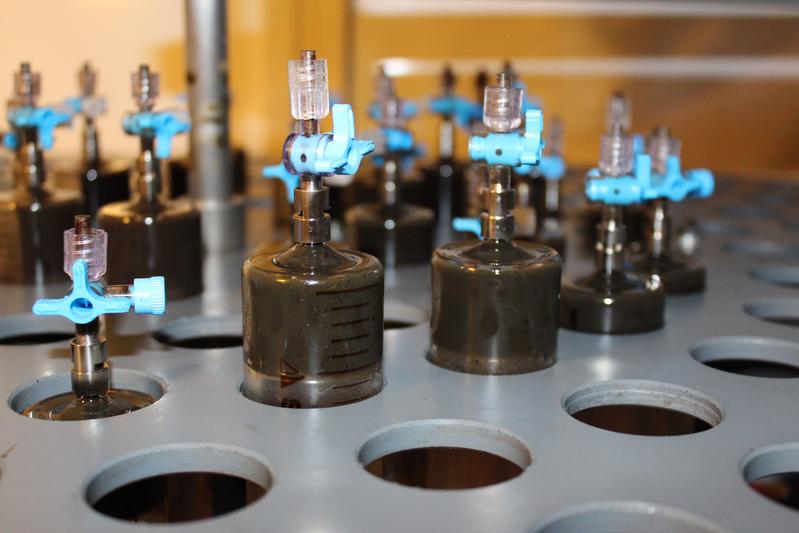
Biogas Microorganisms: Unlocking Waste-to-Value Potential

Laboratory biogas test at the Leibniz Institute for Agricultural Engineering.
Photo: Werner/ATB
The production of materials and chemicals from renewable resources usually bases on biological or thermochemical processes. The latter possess the advantage of very high reaction rates. At temperatures of 250°C and above, even complex organic compounds that are recalcitrant to biologic degradation like lignin are rapidly decomposed.
However, thermochemical processes are highly unselective in their product pattern. Besides the target products a range of more or less problematic organic compounds is formed. This decreases the product yield and causes additional costs for the waste water treatment.
The researchers in Potsdam have put focus on the liquid by-products of thermochemical biomass conversion. This includes waste waters from HTC as well as pyrolysis. Both processes are highly flexible both in their feedstocks and products and are therefore expected to fulfil important roles in future bio-refinery concepts. However, until now a major problem is: These processes form waste waters that contain various environmental hazardous substances such as phenols, furans, aldehydes and ketones.
The main product of pyrolysis and HTC is biochar, a carbon and energy-rich solid material, which can be used as fuel, but also for a range of further applications from soil amendment to carbon electronics. By-products of pyrolysis are the so-called syngas, which can be used as a fuel, and a condensate composed of volatile compounds, for which no satisfying type of use exists today.
In the HTC, a process liquid is formed which contains a wide variety of organic and mineral compounds. Thus, both waste waters from HTC and pyrolysis require an effective treatment before they can be released into the environment.
In their latest article published in the scientific journal “Bioresource Technology”, the Potsdam researchers now report on the successful anaerobic biological conversion of water-soluble pyrolysis condensates in laboratory tests.
The condensates were obtained from pyrolysis of solid digestate, which is a by-product of biogas production, at temperatures between 330°C and 530°C. Large parts of the organic compounds contained in these condensates could be degraded and transformed into bio-methane. After the biological treatment, the analysed toxic components 5-HMF, phenol, furfural, catechol and guaiacol were removed below detection limit.
Only cresol remained detectable, but was still degraded by 10 to 60 %. The temperature at which the condensate was produced had strong impact: the higher the pyrolysis temperature the less organic compounds were degraded. In detail, increasing the temperature from 330 to 530°C decreased the overall degradation efficiency, expressed as the chemical oxygen demand (COD), from 57 to 37 %.
“Our results indicate the range of synergistic options to combine thermochemical processes like pyrolysis and HTC with biogas production”, project leader Jan Mumme emphasizes the added value of these integrated systems. “In addition to the production of biochar, energy can also be obtained in form of biogas”, adds junior scientist Tobias Hübner. “Recently, high research activity is seen concerning the integration of thermochemical and biological processes following bio-refinery concepts. With our research results we want to contribute to a better economic performance and a higher sustainability of these systems”, concludes Mumme.
The use of HTC waste water for biogas production was demonstrated by the APECS researchers earlier in 2013. In another joint study with Fraunhofer Institute for Chemical Technology ICT Pfinztal, quantification of individual substances in the HTC liquid by NIR showed promising results that could lead to an advanced control of biomass conversion and, thus, to higher efficiency.
The project “APECS – Anaerobic pathways to Renewable Energies and Carbon Sinks” was funded 2009 to 2014 by the German Federal Ministry of Education and Research (BMBF) under the funding scheme „Bioenergy 2021“. Project leader Dr. Jan Mumme currently works as guest researcher with the UK Biochar Research Centre at the University of Edinburgh.
Literature:
Hübner, T., Mumme, J. (2015): Integration of pyrolysis and anaerobic digestion – use of aqueous liquor from digestate pyrolysis for biogas production. Bioresource Technology, DOI: 10.1016/j.biortech.2015.02.037
Wirth, B., Mumme, J. (2013): Anaerobic digestion of waste water from hydrothermal carbonization of corn silage. Applied Bioenergy 1, 1-10. Available online at: http://tinyurl.com/oqwrksp
Reza, M.T., Becker, W., Sachsenheimer, K., Mumme, J. (2014): Hydrothermal carbonization (HTC): near infrared spectroscopy and partial least-squares regression for determination of selective components in HTC solid and liquid products. Bioresource Technology 161, 91-101. Available online at: http://tinyurl.com/lhm7op2
Contact:
Dr. Jan Mumme – Leader of the junior research group APECS
jan.mumme@ed.ac.uk; jmumme@atb-potsdam.de
Helene Foltan – Communication
Phone: +49 (0) 331 5699-820, mail: hfoltan@atb-potsdam.de
Leibniz Institute for Agricultural Engineering Potsdam-Bornim (ATB)
Max-Eyth-Allee 100, 14469 Potsdam, Germany, http://www.atb-potsdam.de












